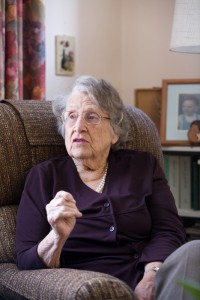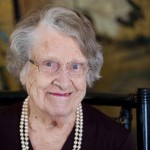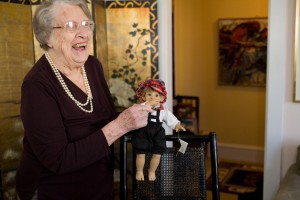Thursday
Featured StoriesMaking Space to Be Human: An Interview with Virginia Hilliker
At ninety-four, Virginia Hilliker has more life in her than many of her middle-aged friends. As one of them, I often feel that I’m trailing behind her, trying to keep up with her wit and wisdom in a conversation. Virginia has been a teacher and a therapist for most of her adult life. Over the years, many children and adults in the Shambhala Buddhist community have been her clients, starting in the San Francisco Bay Area in the 1970s, then in Boulder, Colorado in the 80s, and now in Halifax, Nova Scotia. Virginia still sees clients several days a week, which may help to keep her young, and definitely helps to keep many of us a little more sane.
I’ve come to talk with Virginia on a cold February day in Halifax, but it’s very warm and inviting in her apartment. While Marvin Moore is photographing this beautiful woman, I’m talking with her about her life. She frequently laughs or even giggles, and at other times is gesturing seriously to make her points. Her intense blue eyes capture one’s attention.
A few years ago, Virginia finished Making Space for Children: Creating a Sane Environment, a book based on her many years of work with children. Cheryl Campbell, then the Director of Shambhala Media, inspired Virginia to review years of notes and transform them into this slim, but potent, volume. Almost every week, Cheryl would drop by Virginia’s house at the end of a work day to ask how it was coming. Virginia tells me how her sister’s granddaughter helped her with the book: an editor by trade, she read through the material and told Virginia there was enough for at least two books. This, says Virginia, gave her permission to focus on what meant the most to her – about how the understanding and view of basic goodness underlies how we relate with our children and families. Debbie Kaetz worked many hours with Virginia distilling the final product.
An excerpt from Making Space for Children: Creating a Sane Environment
Basic goodness
The point we emphasize is strong confidence in our original nature.
Shunryu SuzukiThis book is based on the idea of the basic goodness of humans. Basic goodness is the unconditional state of wholeness, healthiness—a healthy resting spot, or simple basic being—which is awake. Chogyam Trungpa, a Tibetan meditation master and my teacher, said, “Buddhist psychology is based on the notion that human beings are fundamentally good. Their most basic qualities are positive ones: openness, intelligence, and warmth.” If we are willing to take an unbiased look, we will find that, in spite of all our emotional and psychological ups and downs, there is something basically good about our existence as human beings.
In his inaugural address, Nelson Mandela also talked about this basic goodness. He said that “man’s goodness is a flame that can be hidden, but never extinguished”. If anyone had reason for believing in the destructiveness and ugliness of man, it was Nelson Mandela; however, throughout his years in prison he maintained his belief in basic goodness.
Eric Berne, the founder of Transactional Analysis and another of my teachers, spoke of an “innate sense of fairness”. When people shed some of the rigid and prejudicial ideas they have been taught about right and wrong, they discover a basic sense of decency in themselves.
One part of this basic human quality is our impulse to care for children. We are shocked when we hear of children who are neglected or abused. Although we may not always agree on what is good for children, the basic idea of caring for them is always present. Of course, there are people whose lives have become so distorted that they have lost touch with this ability to care, but for most people it is a fundamental part of their lives. Even young children seem to have a sense of what is healthy for them, and a healthy child will protest strongly if something in the environment is not healthy.
Introduction to Making Space for Children: Creating a Sane Environment
By Deborah Kaetz, M.Ed., M.S.W.
Twenty-one years ago, Virginia Hilliker drove her then brand new Toyota to Nova Scotia. At 73, she took a brave leap and became a Canadian immigrant and an honored elder of the Buddhist ex-patriot community that migrated to Nova Scotia in the 1980s. Up until that point, Virginia had nurtured her two boys and their families, learned how to fly a plane, traveled and taught extensively, and benefited many through her practice of child, adolescent, marriage and family therapy. I met Virginia soon after she arrived in Nova Scotia. She has been a dear friend, a colleague on the path of therapy and Buddhism, and a revered role model, though she does not think of herself that way and has always seemed twenty years younger than she ever is. She loves to eat well, attend plays and concerts, and would still travel the world if her knees were willing. Virginia and I have traded mystery books; the basket in the entrance hall of her apartment is always full of choice pickings. When she turned 80, she decided to become a writer herself, and I have shared with her the pleasures and pains of birthing this book.
Born in 1915 in Bradford, Pennsylvania, Virginia, her two siblings, her school teacher mother, and salesman father weathered the 1929 Great Depression by cultivating their garden, raising chickens and cows, and learning about self-sufficiency. She graduated from Allegheny College in 1937 with a mathematics major. After raising two sons, she returned to school at Syracuse University and received an M.A. degree in Family Relations and Child Development. She soon became the director of the Early Childhood program and pre-school at Cazenovia College in Syracuse. When the finger paints were put away and the last parent had picked up the last child, or today when she needs to clear the air, the mind of the teacher/therapist gives space to the mind of the mathematician: “My relaxation through the years has been working with figures, word games, something that has an answer. It is very relaxing and restful for me, because when you work with people, you have no idea whether you are right.”
That logical mind was one of the qualities that first attracted her to a major figure in the history of modern psychology, and subsequently a primary influence in Virginia’s own life. One summer, when she was teaching a summer course in child development at Syracuse University, Virginia experienced a rare moment of synchronicity. Teaching that summer in the next room over, was Eric Berne, the father of Transactional Analysis (TA) and author of the book Games People Play. Virginia offered to drive him to work in the mornings and they became friends. She liked his intelligence, his down-to-earth way of looking at life, and, of course, his logical mind. He invited her to study with him in California if the opportunity arose.
However, first came a chance to travel to Japan. A group affiliated with the Unitarian Universalist Church would be speaking English with Japanese teachers of English. She returned to Japan the following year, this time having left her job and her roots back in Syracuse.
“I had to quit my job before I left. It was a great job and I was doing a great job. I was directing the preschool program and the teacher training, which had become a recognized two-year program. But the situation felt like a dead end to me. My two boys had gone into the navy. There was very little play. At the last minute, I got a job at San Francisco State College.”, and the opportunity to study with Eric Berne.
She moved to San Jose, California and began to attend Eric Berne’s seminars in Carmel and San Francisco. In time, she enrolled in a Ph.D. Program at the University of California, and became licensed as a Family and Marriage Counsellor. Having already raised her own family, and completed one teaching career, Virginia was quietly moving forward into new ground. Although “several years older” than many of Berne’s students at the time, she dove right in and began leading TA groups, and also teaching at a local college. Her study of Transactional Analysis has very much shaped her work with children and adults.
Eric Berne taught that we have three ego states: parent, adult and child. Virginia observed, “It seemed to me that people were acting out of their child ego state without any way of using their logical mind or the intelligent mind to deal with the problem. They would just go into the feeling part of it. If a person were highly disturbed, he (Berne) would say to him or her, ‘It isn’t time to be crazy now.’ There was a way of reaching their sanity and that was very impressive to me.”
She does not say a lot during therapy sessions, but is able to clarify and focus on what clients need to bring forward. She is also not afraid to become part of the action: “When you work with the Transactional Analysis model, your reaction to what goes on in the room is important. You are part of the equation. You are cheating your clients if you are not actually in the room with them.” With her clients, Virginia is clear and to the point. However, the microscope can just as easily be focused on herself as on a client.
In the early 1970s several of her friends had begun to attend talks by Chogyam Trungpa Rinpoche, a Tibetan Buddhist teacher who had arrived in America via the British Isles.
Chogyam Trungpa taught that we are all born with the quality of basic goodness, which may become obscured by the habitual patterns we develop as we try to cope with our world. Chogyam Trungpas taught Buddhism as a way of looking at ourselves as if through a microscope. In 1973, Virginia left her doctoral program and began to study with Chogyam Trungpa. She became part of the Vajradhatu (now Shambhala) sangha and moved to Boulder, Colorado in 1980 where she was invited to teach in the psychology program at Naropa Institute. She moved to Halifax, Nova Scotia in 1988.
Now, at age 94, Virgina is still a tall, stately woman with a twinkle in her gently penetrating eyes. She has devoted this lifetime to helping children from both troubled and “normal” families to successfully navigate their world. She has also helped their parents learn how to parent while seeing through the eyes of their children, as well as acting with the authority and presence of a well-functioning adult. She says in this book that we have to put our own thoughts and feelings under the magnifying glass and see our ourselves and our children as works in progress, not as finished projects or even as projects to be finished.
The birth of this book has had a long, and at times difficult labor – over eight years from conception to publication. It has been a privilege for me to help Virginia distill so many years of experience into a concise and simple format. This is not a parenting book in the tradition of Barbara Coloroso, or Dr. Phil. In this book, Virginia invites us to go to the roots of behavior, to see the intention behind what we do or say, to co-create our children, and to access the wisdom that is inherent in everything.
More excerpts from Making Space for Children: Creating a Sane Environment
The child’s need to belong
Another basic view taken in this book is that parents are very important to children, and that children realize this. They know at some level that they could not survive without the care of an adult. Some young animals can survive alone very soon after birth, but the human baby needs parental care for years. Children know this, and basically they want to please their parents. If they do not, it is probably because they are having to deal with some push toward growth that conflicts with the wishes of their parents.Growth is natural
Growth is natural and does not need to be forced. The push toward growth is present throughout the life cycle. Whenever a new capacity becomes available, there is an impulse, or drive, to use it. There is discomfort with an environment that does not take into account the need to use these new capacities. In most circumstances, birth takes place when the infant has the capacity to live outside the womb. As the child grows, he has to find the way to use his growing capabilities and still maintain support from his parents.
Children are not programmed like computers
Since the human child is less developed at birth than some other animals, he is freer to develop further and in more creative ways than other animals. This is part of what is called in Buddhist terms, “the precious human birth”. Certain patterns of growth are built into the genetic code, but there is a wide range of choice available.
If the environment in the home is healthy, children are free to develop in their own pattern, finding ways to fit into a family containing other members who also have needs. If the environment is not healthy, children find ways to cope with it, but these ways may not be healthy ones. The child is not seen as conditioned by the environment, and therefore not able to change, but rather as making choices which may then later be changed.
Good news: Each moment is new
Freedom to make new choices is available for both parents and children. Each moment is new. If, as adults, we are following an old pattern, it has to do with choosing that old pattern in the moment. We may be making the same choices we made when we were children because those choices were effective at the time. As adults, we can decide to choose something else. One reason we seem to be stuck in making the same decisions is because, in making different decision, we have to give up a definition of ourselves, and that may be frightening. Our habitual patterns do define us in some way; they make us feel more solid and ongoing.Creating a sane environment in the home is possible
Understanding our children and understanding ourselves as parents can make it possible for us to create gentle, loving relationships in the home.
Closing by Carolyn Gimian:
In the early 1980s, Trungpa Rinpoche invited a group of parents and people working with children to his house, the Kalapa Court, to talk about instituting a ceremony for eight year olds. Virginia was one of those people. Rinpoche talked about how eight year olds in Tibet are given responsibility for caring for herds of animals and said that, at eight, children are responsible for their own karma. Virginia felt this made sense in terms of Western child development. Together with Nancy Craig, Fiz Harwood and others, Virginia helped to create the rites of passage for the eight-year-old children of the Shambhala Buddhist community. They created this rite of passage to help children and their parents mark this transition in life.
This year, Virginia is working with a group of people on a new rite of passage: the rite of passage for sixty year olds! She tells me, with a twinkle in her eye (and her blue eyes truly twinkle), that some of the group think this should be a cruise. All you soon to be sexagenerians: Stay tuned for more information on this celebration.
And to get Virginia’s book, which is not really just for children, click here to go to the book’s page at the Shambhala Shop.
Photographs by Marvin Moore.




















Mar 19, 2009
Reply
What a wonderful story, bravo. I will point to this on shambhalsun.com/sunspace!